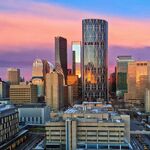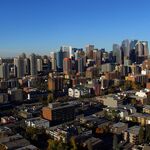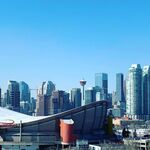CalgaryTiger
Senior Member
Having just been to France. I was very puzzled, that yes, there are homeless people but no and I mean zero zombies. Is it just that the drugs we have here are not there?Not just here, but for most NA cities.
Having just been to France. I was very puzzled, that yes, there are homeless people but no and I mean zero zombies. Is it just that the drugs we have here are not there?Not just here, but for most NA cities.
Pretty much.Is it just that the drugs we have here are not there?
I believe as well you're only allowed to serve alcohol with the fencing set up around the patio, which will probably only be able to fit in the central zoneThis is pretty common in Europe, where they have created pedestrian streets/plazas, and the al fresco dining areas are in the middle of the street/plaza, rather than being abutted right against the building. It will definitely be something that restaurants and servers will have to get used to.
The main benefit I see is that it should improve traffic/visibility for adjacent retail stores, as it will allow better pedestrian flow, closer to the store fronts. Right now, Stephen Ave is a bit of a mine field of permanent/semi-permanent patios along the edges. To me, this is problematic, because pedestrians have to navigate around the fencing/planters that restaurants have installed, which is a particular waste of space during the winter months, when these patios are not in use. I also think this could provide some flexibility for smaller restaurants to expand their outdoor seating area, as they are likely currently limited to the width of their restaurant frontage.
It's also my impression that restaurants will still be able to have patios in the "edge zone", immediately abutting the building, but I'm guessing that it will have to be more "cafe style" furniture, without a defined fencing/planter boundary.
View attachment 650847
Yeah, that seems like an antiquated North American thing. As though the 3 foot fence magically demarcates where liquor can be consumed, while there are people doing illicit drugs everywhere else on the street. Hopefully that can be resolved through a bylaw.I believe as well you're only allowed to serve alcohol with the fencing set up around the patio, which will probably only be able to fit in the central zone
That is a gut punch.Pretty much.

I think this would be a pretty good outcome if it’s achievable. Unfortunately, there’s no putting fentanyl back in the bottle. Decriminalization doesn’t work here because we don’t pair it with strong, enforced treatment. Some provinces, including AB are passing forced treatment laws, but that’s in very exceptional circumstances, requiring multiple inputs from the judicial and medical systems. It’s only going to affect those with past violent tendencies or contact with these systems and won’t help/affect most drug users. Those decriminalization programs in Europe were paired with mandatory (not necessarily punitive) treatment for everyone. I think that’d be a good start, get those that are not fully gone to right their life, and stem the flow of more people having severe addiction issues.at best very slowly making it better.
Yeah, my conclusion was all you can do is try to slow down the demand. Safe injection was/is a communications problem. If you supplemented the street supply with a safe supply that's some demand gone. That ship has sailed. Treatment does also removes some demand but we're undertaking a decades long process. I truly believe it will take that long. Unless you take dramatic, and almost unlawful action, of rounding them all up and putting them out to a "wellness" farm until they're "better".I think this would be a pretty good outcome if it’s achievable. Unfortunately, there’s no putting fentanyl back in the bottle. Decriminalization doesn’t work here because we don’t pair it with strong, enforced treatment. Some provinces, including AB are passing forced treatment laws, but that’s in very exceptional circumstances, requiring multiple inputs from the judicial and medical systems. It’s only going to affect those with past violent tendencies or contact with these systems and won’t help/affect most drug users. Those decriminalization programs in Europe were paired with mandatory (not necessarily punitive) treatment for everyone. I think that’d be a good start, get those that are not fully gone to right their life, and stem the flow of more people having severe addiction issues.
It's also a proportional problem related to local population. The Beltline has continued to grow and get increasingly vibrant despite these issues - it's reached a critical mass of local population that the issues themselves seem less severe because there's more other "normal" activity going on.Yeah the reality is that almost all the "vibrancy" issues in the inner city stem for the drug/homeless problem, and that can't be solved via nicer urban design. No matter how many nice platters, or redesign sidewalks, or pickle ball courts you put in...most people don't want to hang around zombies and skids. There's no quick solution for that by any means (and requires action from many sides), but fix that and I bet that a lot of places suddenly will become a lot more vibrant. There's a reason why University District is thriving, while a place like EV isn't.
It's a tough issue to deal with. I can't help but wonder if these addictions are even resolvable, with relapse rates for Fentanyl high no matter treatment is used. From what I've read it looks like forced treatment doesn't return better results than what we currently have, but I suppose the addicts would at least be housed and looked after rather than out on the street. If we are at a spot where we can't reasonable treat the addictions, or we have a really low success rate rate, we need to think outside the box on how to stop the flow. Maybe there needs to be harsher punishment for people trafficking and selling the Fentanyl?Yeah, my conclusion was all you can do is try to slow down the demand. Safe injection was/is a communications problem. If you supplemented the street supply with a safe supply that's some demand gone. That ship has sailed. Treatment does also removes some demand but we're undertaking a decades long process. I truly believe it will take that long. Unless you take dramatic, and almost unlawful action, of rounding them all up and putting them out to a "wellness" farm until they're "better".
I guess maybe I got a little too focused on demand, maybe you can do some things on supply but I wouldn't put that much money and effort into trying to stop supply. Supply to me feels a bit whack-a-mole.Maybe there needs to be harsher punishment for people trafficking and selling the Fentanyl?
It does feel like it. There will always be supply, even with harsher penalties, but maybe it would slow down supply enough to at least slow down the rate of new users, and help slow down the amount of new dealers? Right now there's not much of a deterrence to trafficking or supplying fentanyl. Someone got 16 years for tracking recently, but many of the sentences are like 6-10 years, which in Canada translates to about half that.I guess maybe I got a little too focused on demand, maybe you can do some things on supply but I wouldn't put that much money and effort into trying to stop supply. Supply to me feels a bit whack-a-mole.
I once got burnt sitting under an umbrella all day because the sun was reflecting off the sand. So no matter what, I'm vulnerable.Too bad they didn't consider the sun position when placing those chairs and umbrellas. They run north-south with the head at the south end. Enjoy your feet in shade and the top of your head burned.




